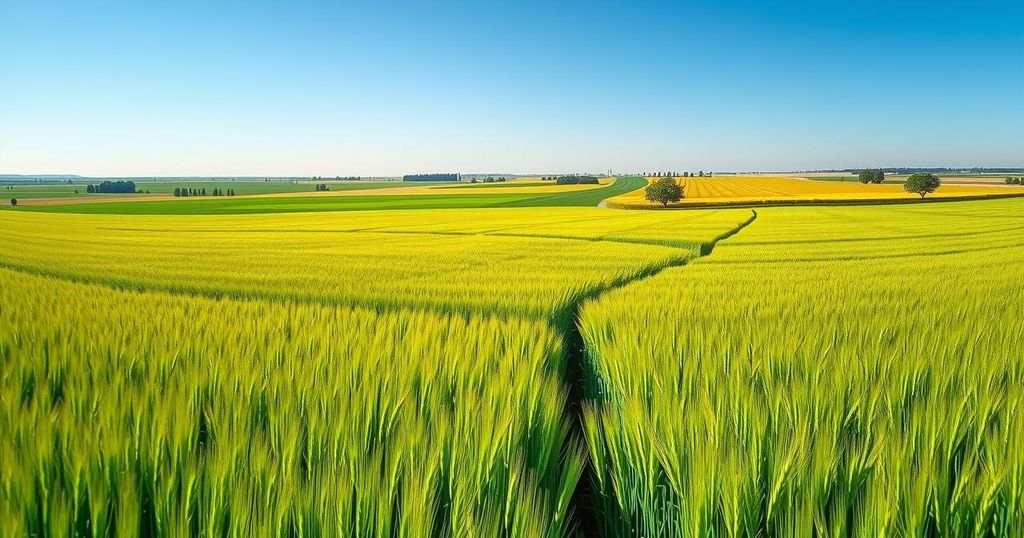Argentina’s Agricultural Boom: Weather-Driven Yields and Export Opportunities

- Argentina’s agricultural sector is experiencing a renaissance driven by weather and global demand.
- The wheat planting season has seen a significant increase, reaching 72.7% completion in late June.
- The soybean harvest exceeded expectations, with production hitting 52.0 million metric tons this year.
- Reduced export taxes have enhanced competitiveness in the soy market, boosting exports.
- Potential export opportunities exist for Argentine wheat to meet Egypt’s import needs.
Argentina’s Agricultural Sector Is Set for Transformation
Argentina’s agricultural sector stands on the brink of significant transformation, bolstered by an ideal mix of favorable weather patterns, strategic policy changes, and surging global demand. Reports indicate that key crops, specifically wheat and soybeans, are set to thrive this year, marking a promising turn after years of fluctuations. Particularly, the country’s agricultural renaissance reveals strong production capabilities and a potential for record exports, making it a focal point for both observers and investors alike.
Wheat Planting Shows Positive Trends Amid Weather Changes
The Buenos Aires Grains Exchange (BdeC) shared encouraging news recently regarding the 2025/26 wheat planting progress, having sown 72.7% of the anticipated area of 6.7 million hectares as of late June. This figure has significantly increased from just 60% a few weeks prior, thanks to a bit of luck in weather. A cold and dry July has enabled farmers to wrap up harvesting soy and corn before turning their attention to wheat. While some areas, such as Buenos Aires province, encountered setbacks earlier due to excessive rains, a favorable dry spell in June has made life easier for farmers as they aim for optimal planting conditions.
Soybean Harvest Achieves Record Growth Amid Concerns
Significantly, Argentina’s soybean harvest for the 2024/25 season has concluded with impressive figures, registering at 98.3% completion. USDA statistics reveal that the total production hit 52.0 million metric tons, marking a remarkable 7.9% jump from last year and well above the five-year average by 23%. This is bolstered by an expanded planting area of 17.3 million hectares, the largest area sown since the 2015/16 season, which has offset regional yield losses following farmers’ shift away from corn due to various issues affecting that crop. Further adding to the momentum has been a reduction in the export tax on soybeans, now at 26%, after previously being 33%, thus improving Argentina’s competitiveness in global markets.
Strategic Export Opportunities Await Investors
As if the current situation could not get better, Argentina’s agricultural landscape uniquely positions itself to meet Egypt’s rising wheat import requirements, predicted at 13 million metric tons for the 2025/26 season. This robust potential crop signals an opportunity to lessen Egypt’s dependence on traditional Black Sea suppliers, which could help stabilize global prices. Furthermore, the surplus in soybean production primarily supports exports of soybean oil and meal, accounting for a substantial 85% of the nation’s agricultural export values. Investors seeking opportunity should consider wheat futures, as pricing at the Chicago Mercantile Exchange (CME) is likely to rise if output matches forecasts. Agribusiness stocks, especially companies like Cargill and Bunge Limited, are also viewed as giving a compelling opportunity for long-term growth through expanded margins.
Understanding the Risks in Argentina’s Agricultural Growth
Despite the optimistic outlook, there are still significant risks to consider that could affect this agricultural boom. One major concern is weather volatility; if August turns out to be dry, it could severely impact wheat yields. Furthermore, geopolitical factors, particularly related to Egypt’s procurement strategies and any shifts in Black Sea supplies, pose additional pricing risks. Lastly, upcoming changes in export tax policies, with reductions set to expire in June 2026, introduce an element of uncertainty that investors should not overlook while navigating the evolving landscape.
In summary, Argentina finds itself in an advantageous position where favorable weather, policy adjustments, and robust global demand converge to yield a striking agricultural environment. With key players like wheat and soybeans leading the way, investors are likely to find substantial opportunities for growth. Careful monitoring of crop developments, geopolitical dynamics, and potential policy shifts will be vital as they assess the long-term viability of this agricultural boom.







